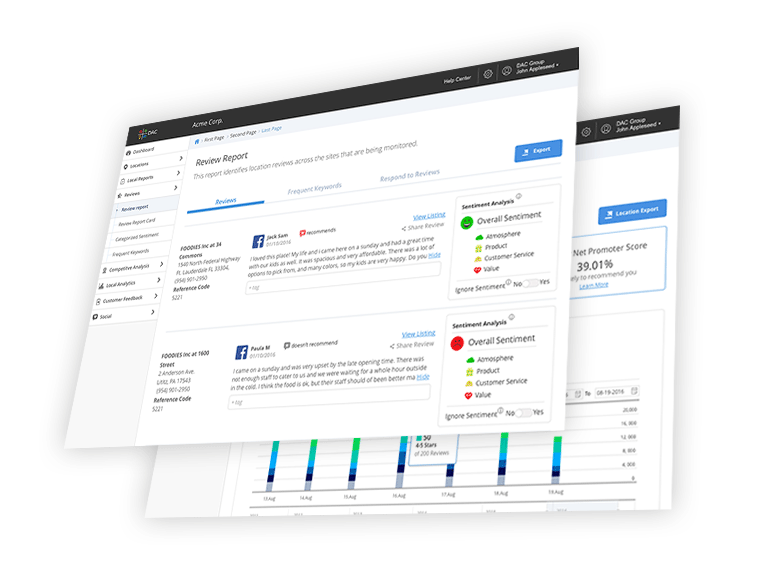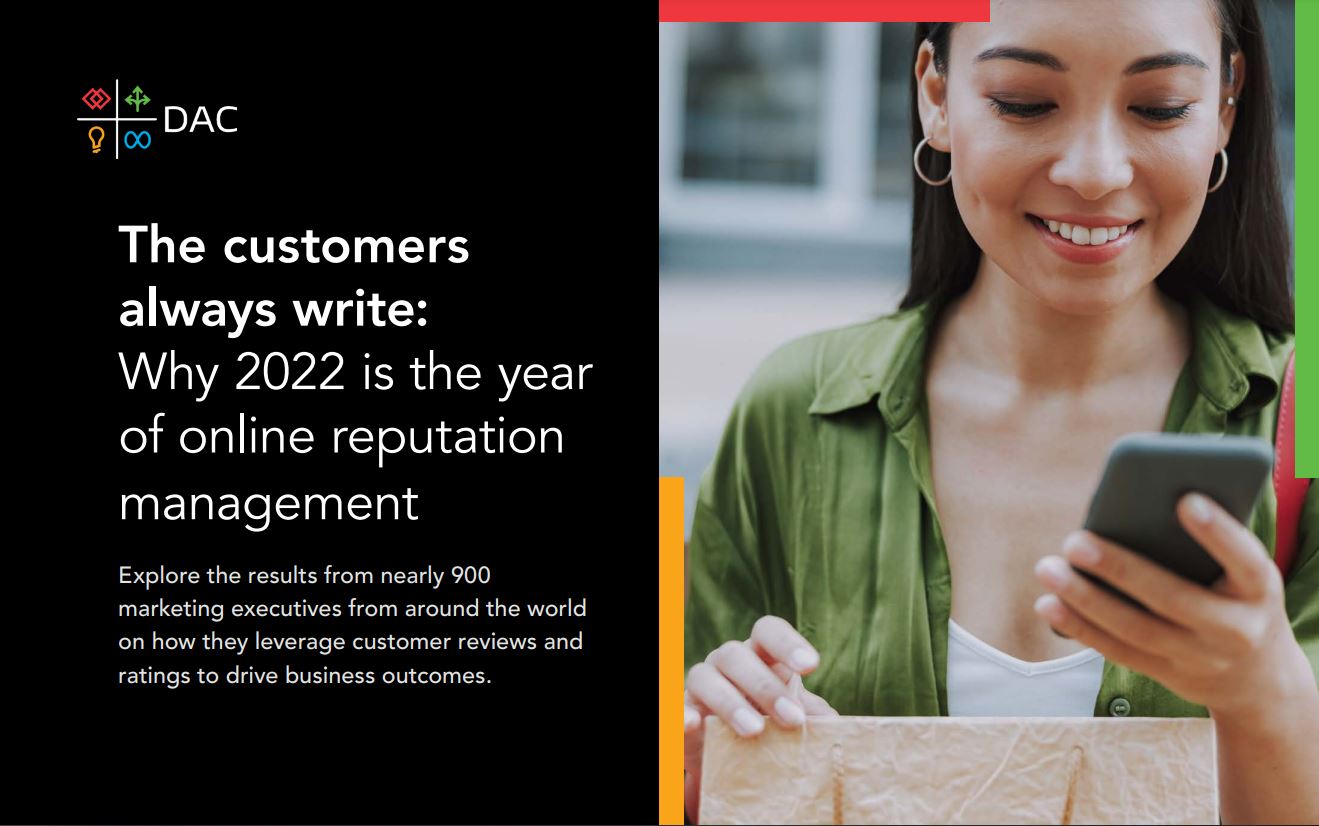It has been especially difficult for businesses to evaluate if they meet benchmarks for online reputation management over the past two years. Year-over-year analyses have relied on frustratingly imperfect information as industries dealt with not only the changing business landscape but the all-encompassing impact of COVID-19. As a result, it has been almost impossible to tell if negative reviews are due to strategic mistakes, pandemic-related fluctuations, or a combination of both. Without review benchmarks to compare against, all businesses have been able to do is guess—and too many business owners have used the pandemic as an all-purpose excuse for downward-trending sentiment.
Few possess the knowledge to set benchmarks outside of their own business, and fewer still can confidently set such benchmarks across entire industries. But we’ve stepped up. Utilizing our data set of hundreds of clients across dozens of industries, we can reveal the review benchmarks businesses need in order to determine if they’re weathering the storm as effectively as their rivals or if there may be something other than the pandemic holding a business back.
How we sliced and diced our data
To begin, it is important to note that our data sets are looking at year-over-year comparisons of April 1 2020 to March 31 2021 versus April 1 2021 to March 31 2022. This timeline allows a complete view of how businesses handled initial lockdowns and how they adapted when pandemic procedures became commonplace. It also includes the holiday season because although the past two years have felt like one endless season, the golden quarter still exists as the most important time of the year for many an industry.
It is also to be noted that we are looking primarily at businesses within the US, Canada, and Europe. We have data sets available in other geographies, but benchmarks for industries vary wildly across continents even in the most standard of scenarios. Certain industries, such as health insurance and real estate, have obvious and drastic differences depending on the region—and without a sample size carrying into the thousands, we cannot provide viable data for other regions.
Data sets are therefore also limited by the number of clients we have within those industries. Our large client base does provide a rough approximation of how businesses are distributed within industries in the US, Canada, and Europe, but this also means that prominent business types in these countries—such as retail—will see greater representation than more niche industries such as PO box providers. Nevertheless, DAC’s client base still acts as a microcosm of businesses within those regions.
High-level considerations
With that, let us first see what review benchmarks we can set for general business performance before diving into each industry in detail.
Average star rating: 4.0
Average # of reviews per location: 215
YoY star rating change: -0.01
YoY % review count change: +32.38%
The average star rating and number of reviews per location is not surprising given how hard Google has pushed for reviews in the past few years. Every business should strive for the coveted 4.0+ star rating or miss out on Google searches that include the terms “best”, “top”, and similar superlatives. The average review count surpassing 200 and YoY review counts increasing by more than 32% can be attributed to two factors:
- Google forced a temporary review pause in Q2 of 2020 after customers left reviews regarding COVID-19 issues that were beyond individual business’s control.
- Google stepped up its efforts to turn its local listings into a major review platform. If your business hasn’t already encouraged greater numbers of fresh reviews, you’re falling behind your competitors.
Google wants text-heavy reviews because keywords within those reviews matter almost as much as raw star ratings. Bold review snippets appear in the map pack and local finder when a query matches up with the content of a user’s Google Business Profile (GBP) review. Google also encourages business owners to respond to reviews (both good and bad), which is proven to increase the frequency of text-based reviews. A large volume of written reviews matters more to Google than star ratings alone, and bold keyword snippets extracted from reviews are known to have a significant impact on click-through rates.
The tale of the tape
The average numbers above cover every industry, but we know that customer experiences and perceptions vary drastically from industry to industry. In the table below (which shows some but not all of the industries we analysed), the three industries with the lowest average review scores are highlighted in red while the three industries with the highest average review scores are in green.
| Industry | Avg. Star Rating | Avg. # of Reviews per Location | YoY Star Rating Change | YoY % Review Count Change |
| Alcohol | 4.3 | 174 | -0.05 | -8.95% |
| Auto Repair | 4.2 | 283 | 0.05 | 16.33% |
| Auto Sales | 4.1 | 137 | 0.36 | 51.89% |
| Energy | 3.6 | 26 | -0.01 | 71.51% |
| Financial Services | 3.3 | 9 | -0.18 | 0.91% |
| Fitness | 3.8 | 230 | 0.03 | 81.79% |
| Gas Stations | 3.8 | 62 | -0.13 | 58.77% |
| Grocery Stores | 4.2 | 421 | -0.01 | 0.79% |
| Healthcare | 4.3 | 86 | -0.05 | 76.06% |
| Home Services | 4.2 | 2231 | -0.18 | -17.39% |
| Insurance | 3.9 | 86 | 0.26 | 36.46% |
| Pharmacy | 4.0 | 25 | -0.04 | 73.50% |
| Real Estate | 4.2 | 49 | -0.08 | 5.91% |
| Restaurants | 3.9 | 410 | -0.08 | 49.60% |
| Retail | 4.3 | 165 | 0.01 | 22.83% |
| Waste Management | 3.9 | 268 | -0.18 | 37.31% |
| TOTAL | 4.0 | 291 | -0.02 | 35% |
Those with their work cut out are the usual suspects. Rarely do customers have anything positive to say about financial institutions or a local gas station, but recessions and rising gas prices are beyond their control and lower average scores do not necessarily mean these businesses delivered subpar service. Every business should strive to surpass that 4.0-star threshold, even if it’s a loftier goal in some industries than others.
Certain industries also see very low average review counts. Financial service providers, for example, commonly see review counts in the single digits, which means a single positive or negative review can impact their search visibility. If you’re in such an industry, it’s critical to encourage customer feedback. You need more than 10 reviews for Google to give you credence and, beyond that 10-review threshold, you need a steady supply of reviews less than three months old. Even if you can’t realistically sustain a high volume of reviews, you should at least aim for Google’s minimum threshold of 10 reviews per quarter. This is the only way to make sure reviews contribute to your pursuit of the top search positions.
Finally, the significant growth in overall review volume suggests that users are influencing how prospective customers consider their options. Every business should respond to reviews to manage their reputations in positive ways. Doing so is proven to influence star ratings as much as half a star in the positive direction.
So… what does this mean for your business?
Although the specifics will inevitably vary across industries, one thing is universal: Engaging with reviewers to amplify positive sentiment will not only boost your reputation but drive business growth. After all, a significant percentage of all online leads come from GBP via either Google Search or Maps, and Google is using review content to determine rankings in more scenarios than the aforementioned “best” or “top” queries. In other words, the search giant really cares about reviews—and you should too.
Regardless of how much Google tinkers with its algorithms, your destiny will remain in your own hands with a comprehensive reputation management strategy in place (and our experts in your corner). Simply ask us how you measure up against your competition and we’ll go from there.
In the meantime, don’t miss our exclusive reputation management survey of nearly 900 marketing executives from around the world. Some of our findings have to be seen to be believed…






